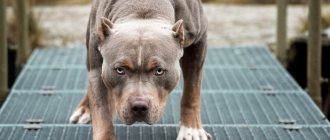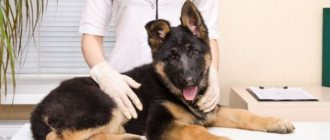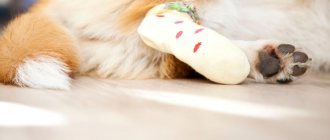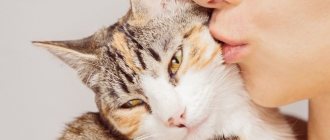The cat stretches its paws
The illnesses of our little brothers greatly worry and upset their owners. However, you can fight them if you know what the animal is sick with and how to treat it correctly. It is noteworthy that cats, like other animals, quite often suffer from diseases that are associated with impaired functioning of the limbs (read more about paw diseases in cats). However, such diseases do not always arise due to unsuccessful landings on the paws. Often, cats pull their paws due to problems with internal organs. Well, here’s what they are, and why – our publication will tell you about this today...
What to do if a cat is limping on its hind leg?
Sometimes an owner is faced with the fact that his beloved cat is limping on his hind leg.
There are many reasons for this phenomenon, and it is important to determine exactly what caused the lameness. A sick animal tries not to put any strain on its paw, almost never steps on it, and falls heavily when walking. The cat stops running, climbing trees, jumping through cabinets because it experiences pain and discomfort when moving and putting stress on the affected limb. It is necessary that the treatment is carried out correctly and the disease does not become chronic. If, in addition to lameness, the owner notices that bald spots are forming between the hind legs, contacting a veterinarian should be urgent. In some cases, lameness is an indicator of an emergency condition. Sometimes an owner is faced with the fact that his beloved cat is limping on his hind leg. There are many reasons for this phenomenon, and it is important to determine exactly what caused the lameness. A sick animal tries not to put any strain on its paw, almost never steps on it, and falls heavily when walking. The cat stops running, climbing trees, jumping through cabinets because it experiences pain and discomfort when moving and putting stress on the affected limb. It is necessary that the treatment is carried out correctly and the disease does not become chronic. If, in addition to lameness, the owner notices that bald spots are forming between the hind legs, contacting a veterinarian should be urgent. In some cases, lameness is an indicator of an emergency condition.
Why might a cat shake its paw or pull it back?
Sometimes cat/cat breeders notice that the pet is shaking its paw or pulling it back.
This can happen for several reasons:
- Ticks. The parasites attach themselves to the soft pad on the paw and burrow into the flesh. This causes severe discomfort to the animal, so the cat shakes the limb to relieve the pain. The pet owner can detect the tick by visually inspecting the paw and remove it.
- Worms . The appearance of helminthic parasites in an animal’s body can be noticed by the following symptoms: the cat is constantly restless, shakes one or the other paw, and sometimes eats poorly. Worm eggs can also enter the human body when he caresses or kisses a pet, so medical consultation is extremely important here.
- Inconvenience after sterilization. After sterilization, a special blanket is put on the animal to prevent licking the healing scar. It usually bothers cats, and they try to remove it in every possible way. At the same time, they can shake their hind legs.
- Scotch tape, glue, chewing gum, splinter. Cats, especially those who walk outside, often catch pieces of adhesive tape, chewing gum, resin, splinters, etc. on their paws. Sensing a foreign object on the pad, the pet shakes the limb in an attempt to get rid of it.
Be sure to read:
What causes growths on the pads of cats' front or hind paws?
Reasons why a cat is limping
There are many reasons why a cat does not step on its hind paw, as well as its front paw. Often the owner can immediately understand what happened, but there are also situations when an adult pet or kitten simply returns from a walk, limping heavily and mewing pitifully. In this case, the first thing to do is to carefully examine the paw, which the animal cannot stand on normally.
Sometimes the case is quite simple, and the owner can independently provide assistance, thanks to which the cat does not limp on the same day. This is possible with minor physical damage. Complex injuries are often characterized by the fact that both hind legs are immediately affected and lameness persists for a month or more. Treatment in such a situation should be started as soon as possible.
The following reasons may cause the problem::
- Stinging insect bite - the bites of wasps and bees are painful, and therefore, if a cat steps on an insect, he is guaranteed lameness for 2-4 days, even after the owner removes the bee sting or treats the wasp sting. The left or right limb may be affected. If the bite occurred 7-9 days ago and the cat is still limping, a visit to the veterinarian is required;
- Injury to the interarticular area - often occurs during a fight between cats if teeth are used; and also during active climbing on trees that have sharp thorns or twigs. If a cat is not careful, or gets too carried away with tracking birds, it can run into them. The injury most often affects the hind legs, since the animal usually still sees the place where the front paw is placed;
- Dislocation - occurs when unsuccessful jumps and falls cause unnatural movement of the head of the bone in the joint, causing it to come out of it. The paw completely loses mobility and hangs helplessly. Acute pain at the time of injury can cause the animal to go into shock. In this case, the cat may limp on its right or left hind leg. Even with treatment, the cat limps for a long time;
- A sprain is the most common limb injury in cats, in which a minor tear of part of the fibers of the ligaments occurs, causing pain and swelling in the paw. The cat limps quite heavily, but his general condition does not suffer. The animal remains cheerful and does not lose its appetite. Lameness usually goes away within a few days even without treatment. In case of severe sprain, to speed up the recovery of the ligaments, a course of therapy with the drug travmatin, which is administered in the form of injections, is indicated. The animal limps long and hard;
- A bruise is of a traumatic nature. If the injury is not severe, then the cat limps slightly and not for long. With a severe bruise, the cat falls seriously on its back paw, which looks swollen. The pet is limping in such a way that it cannot be ignored. If you move the fur apart, a pronounced hematoma will be clearly visible;
- A fracture is the most severe injury in which the integrity of the bone is disrupted. The cat is not only limping, but almost unable to stand on his paw. Occurs when a strong blow or paw is pinched. In rare cases, physiological fractures are possible, which occur due to the fact that the bones lose their natural strength. Such fractures occur even with minor impact on the bone. The cat is limping and cannot stand on its paw;
- Spinal injury in the lumbar region - with such damage, a disturbance in the transmission of nerve impulses occurs, due to which the movement of the hind legs is difficult and limited. In severe cases, complete paralysis of the hind limbs occurs. In case of injury without paralysis, lameness is observed immediately on 2 hind legs and can be very specific;
- Arthritis or arthrosis of the hip joint - the disease can be unilateral or bilateral. The animal limps in front of him, also wobbling its pelvis. It occurs most often in older cats, but can also affect young animals if they have suffered serious trauma to the pelvic area. With this phenomenon, lameness increases gradually, worsening the cat’s quality of life. Treatment is aimed primarily at slowing the progression of the pathological process. A complete cure is impossible.
Diseases of the joints and bones
Joint and bone diseases appear in cats, as a rule, at 7-8 years of age - these are the first signs of aging. However, young individuals often develop ailments, many of which are transmitted genetically. Common diseases of the joints and bones of felines include arthrosis and arthritis, osteochondrosis, traumatic arthrosis, osteomyelitis, etc.
Arthrosis
Arthrosis is a non-inflammatory chronic disease. It is asymptomatic for a long time - degenerative reformations in soft tissues, bones and cartilage develop gradually. One of the common causes is a congenital defect of the anatomical structure of the animal. Mostly adults are affected, but sometimes the disease also affects young pets.
Be sure to read:
The cat's lower lip is swollen: causes, symptoms, what to do, medication and alternative treatment
Traumatic arthrosis
Traumatic arthrosis is caused by injuries received in youth. Bruises and dislocations that go unnoticed by the owner with age lead to incorrect alignment of bones, cartilage and soft tissues. Often the cause is damage to the lumbar region. This usually happens when landing incorrectly from a height, being hit on the back with a stick, or fighting with dogs. Pinched nerve endings at such a moment lead to severe lameness and discomfort.
Prevention
You can prevent lameness in your cat by minimizing the likelihood of injury. The main preventive measures to prevent a cat from limping are :
- monitoring what is happening to the animal while walking down the street;
- securely closing windows to protect your pet from falling out;
- adequate feeding – proper nutrition provides the animal with sufficient bone strength and tendon elasticity;
- Be careful when closing the doors so as not to slam the cat.
If a cat is limping, you must definitely understand what happened to him.
Sensitive ataxia (proprioceptive)
The consequence of damage to either the posterior columns of the spinal cord, or its roots, or peripheral nerves. Similarly, there are pathologies of the parietal lobe cortex and thalamus opticus.
Tumors and diseases of the intervertebral discs in cats also affect the development of sensitive ataxia.
The main problem is that the animal is not able to bend and straighten its limbs at the joints. The ability to consciously determine the direction of movement is lost.
There is pain in the neck and back area, movements are also painful, and the cat tries to move as little as possible. In severe cases, any movement is simply impossible.
If the brain is damaged in a small part, and treatment was prescribed as quickly as possible at an early stage, there is a chance that the animal will return to normal healthy life.
Why does a cat limp on its hind leg without visible injuries and what to do in this situation?
Lameness that appears in a kitten or adult cat can be noticed immediately, but finding out the reason for this is not always easy. Especially when the cat is limping on its hind leg, but there are no visible injuries. This symptom does not appear just like that; there is always a reason that requires treatment.
First of all, you need to carefully examine the affected paw. You may be able to notice any damage, swelling, or signs of pain. In such a situation, it is important to provide your pet with timely assistance, as serious complications and the need for surgical intervention may arise.
The pet may have no external injuries at all, and sometimes the injuries are almost invisible, but a careful examination can reveal them. If the owner notices that the cat does not step on its hind paw at all, constantly tucking it in, occasionally leans on it, or even limps a little, it is imperative to find out the reason for this. There are many factors that cause such symptoms, and these are not only injuries, but also various diseases.
A cat can limp on its hind leg without visible damage due to various injuries and pathologies in the body:
- hidden fracture;
- cracks;
- sprains;
- joint dislocation;
- splinters in the paw;
- wounds between joints;
- osteochondrosis;
- pathologies of joint formation;
- arthritis;
- osteomyelitis;
- injuries to the lumbar spine;
- arthrosis of the joints;
- osteosarcoma (oncological disease);
- hip dysplasia;
- osteodystrophy;
- dislocation of the kneecap;
- the initial stage of development of calcivirosis (viral disease);
- injection (temporary);
- claws are too long.
A large number of factors leading to lameness of an animal on the hind leg makes diagnosis much more difficult. But many of them can be excluded even during an examination at home. And most joint diseases do not involve changes visible to the eye, but have other accompanying symptoms.
Diseases that affect a cat's joints are often age-related and occur after 6-8 years of life. Some pathologies are congenital and develop gradually; more than a month may pass before the first symptoms appear. Viral diseases and various infections often serve as the impetus for the development of inflammation of joint tissues. If a cat has lameness, the following diseases are possible:
- 1. Hip dysplasia. A genetic abnormality that an animal suffers from birth or has a predisposition to develop. It progresses even at a young age. Lameness in an animal is most noticeable after sleep or rest. When a pet “develops” its limbs after a long period of rest, the symptom is not very pronounced or becomes almost invisible.
- 2. Arthritis and arthrosis. These diseases in most cases occur in older cats and are the most common pathologies affecting the joints. Changes in tissues in both diseases are largely similar, as are the symptoms of their manifestation. The animal tries to move as little as possible - this way the pain practically goes away. The cat refuses to eat and becomes weaker, and sometimes there is a rise in body temperature. Swelling occurs in the joint area, the animal reacts aggressively to palpation, and a local increase in body temperature is felt.
- 3. Patella or luxation of the kneecap. The pathology is rare and is caused by genetic abnormalities or severe trauma. The disease manifests itself abruptly: the animal suddenly begins to limp, it experiences severe pain, to which the cat reacts by meowing and hissing. Treatment is required as soon as possible, since with further development of the disease, surgical intervention will become necessary.
- 4. Osteomyelitis. The disease most often occurs in cats at a young age during the period of active growth. It is characterized by the process of degeneration of bone tissue and its partial destruction, affecting both one limb and several at once. The disease causes severe pain, so the pet does not allow the affected paws to be touched.
- 5. Osteochondrosis. A disease of the spine, as a result of which the spinal roots are pinched or pinched, causing the cat to lame in various limbs. A failure in the formation of cartilage tissue leads to the abrasion of the cartilage layer between the vertebrae, which causes severe pain when moving. A cat sometimes not only limps on its hind leg, but also pulls it back.
- 6. Osteosarcoma. A malignant formation that occurs in bone tissue. Most often it affects animals over the age of 6 years.
All these diseases are serious and require timely treatment under the supervision of a specialist. Typically therapy consists of painkillers and corticosteroids. In severe cases, surgery is required. If you suspect that your cat is limping due to any of the listed joint diseases, you should immediately contact a veterinary clinic. At home, you can only waste time without proper treatment.
In addition to medications, the animal needs constant rest, balanced food or a special diet, which will be prescribed by a specialist, who will also give all other recommendations.
If the animal constantly holds the sore paw suspended, without leaning on it at all, then this indicates a fracture or crack in the bone. The pet will not allow you to touch the sore limb and will aggressively defend it whenever possible to examine it. Usually the cat tries to remain motionless all the time - this way the pain sensations are at least slightly reduced. If you look closely, you will notice swelling of the limb and an increase in local temperature - the damaged paw will become hot. This situation requires urgent intervention.
How to recognize a fracture or bruise
An injury to the paw always becomes immediately noticeable.
The cat holds the injured limb suspended, cannot step on it, and does not allow anyone to touch the sore spot.
A common type of injury in active cats is bruises. Distinctive signs of such damage are:
- swelling of the paw at the site of the bruise;
- hematoma , which can be seen under the fur;
- absence of wounds on the sore paw;
- the structure of the paw is not damaged;
- joints are mobile;
- skin temperature is felt at the site of injury
- The cat constantly licks the sore spot .
A fracture is a more serious injury. Its signs are more pronounced and noticeable:
- violation of the shape of the damaged paw;
- bone instability can be determined by touch;
- swelling in the entire paw.
Only a veterinarian can cope with a fracture
Influence of external factors
Most often, a change in a pet's gait occurs after a street walk. There can be many reasons why a cat is limping on its hind legs.
Wound
Cats can climb trees and jump on branches with ease and grace. However, being too carried away by hunting for birds, your pet may forget about caution. Without noticing protruding twigs or thorns of bushes, the animal can easily get injured by them. A laceration of the pars interarticularis is sometimes the result of fights between cats.
Dislocation and sprain
Unsuccessfully executed jumps end in dislocation of limbs. A fall from a height leaves virtually no chance for a tailed pet to have a painless outcome. Displacement of the head of the joint provokes unnatural movements. The hind leg may completely lose mobility and simply hang down. Severe pain emanating from the moment of movement causes incredible suffering to the animal. A cat limps on its hind leg after a fall for quite a long time.
Sprained ligaments occur due to tearing of some of the fibers in the joints. Despite severe lameness, the cat does not seem to notice the problem. The pet is cheerful and cheerful, there is a “sparkle” in his eyes, there are no hints of pain. Unnatural movements during stretching disappear without a trace after a couple of days. However, serious injuries, such as tendon rupture, require veterinary care.
Insects
A bee or wasp sting is very painful not only for humans, but also for miniature animals. The problem with the paws arises from the fact that, due to inattention, the pet stepped on an insect, which stung in response. In this case, the cat does not step on its hind paw until the bee sting is removed and the wasp sting is treated according to all the rules.
Bruised limbs are the result of a fall from a height. If the cat is limping on its hind legs quite severely, falling when walking, it is recommended to show it to a specialist. You can independently identify a bruise by a change in color and swelling of the paw at the site of the impact. By spreading the fur, you can notice a hematoma - signs of blood accumulation under the skin.
Limb fracture
A fracture occurs as a result of physical influences:
- falling from a height;
- moving by transport;
- strong impacts;
- pinched paw.
The cat is not only limping, he is even afraid to step on the sore limb. Regardless of what type of fracture (open or closed), the animal must be taken to the clinic as quickly as possible. There they will take a picture, put on a plaster cast and send you home.
Spinal injury
A broken spine, and, as a consequence, a disruption in the transmission of nerve impulses, leads to complete or partial paralysis of the hind limbs. The cat “carries” both legs at once - the symptom is quite specific, and it is difficult not to notice it. With such indicators, the animal needs to quickly get to the veterinary station. The further well-being of the pet depends on the duration of paralysis.
First aid for a cat
If you notice that your cat is limping, you need to immediately identify the cause. Having discovered a wound, the first thing to do is disinfect it. If possible, remove hair around the damage and rinse with furatsilin solution.
Limit access of dirt to the wound, apply a bandage and contact a veterinarian.
If you suspect a dislocation, sprain or fracture, provide your pet with maximum rest, give painkillers and cardiac medications, and call a doctor.
X-ray of the hind paw.
An x-ray must be taken at the clinic . If necessary, apply a fixing bandage. The fracture is fixed by applying a splint or plaster cast. Antibiotics and anti-inflammatory drugs are used.
Arthritis treatment
Treatment of arthritis includes taking antibiotics in the form of a dietary supplement - glucosamine, chondroitin.
Taking fish oil and painkillers. A light massage and daily short exercise are indicated. Animals with arthrosis are provided with dietary nutrition and comfortable living conditions.
Drug treatment - decongestants, anti-inflammatory drugs - in the presence of inflammation. Massage, Minin lamp therapy. For severe back injuries, the prognosis is, unfortunately, unfavorable. The animal experiences severe pain, and sometimes limb paralysis is observed.
Importance of treatment
Any more or less worrying situation where a cat does not step on its back or front paw, or both at once, should be discussed with a leading veterinarian. If the problem is left unattended, improperly fused bones during a fracture can significantly worsen the pet’s future quality of life.
A bruise that results in a hematoma may indicate damage to internal organs. Bleeding in the body does not bode well for a pet.
Diagnosis of the causes of limb dysfunction in cats
A veterinarian must diagnose a cat.
In order to determine which of the following reasons is relevant in your case, you should, of course, seek advice from a veterinarian at your nearest veterinary clinic. After examining your pet, the specialist will probably prescribe you to donate the cat’s blood, its urine, and also do an ultrasound of the pet’s internal organs and an X-ray of the spine (more about tests for animals). Thanks to the results of this minimum package of examinations, it will already be possible to draw the first conclusions about the causes of this disorder, and accordingly talk about the treatment of the disease.
Causes of lameness
Understanding the reasons for a pet's lameness is quite difficult, especially if the animal goes outside freely, where it is impossible to follow the cat. Possible reasons for this violation:
- injuries to the spine and hind legs;
- urolithiasis disease;
- stomach pathologies;
- constipation;
- neurological disorders.
If a cat is limping on its hind leg after a fall, the cause may be a bruise or sprain. After assessing the damage using x-rays, your doctor will suggest several treatment options. It may be necessary to immobilize the paw to speed up recovery, but for minor bruises the animal knows what to do, so no specific measures are required. An alarming symptom is lameness on both legs or refusal to move after a fall. This may indicate severe damage to the spine when hitting a hard surface. In this case, the cat should be hospitalized.
Urological disorders and urolithiasis can also cause lameness. If a cat feels pain in the kidney area, it begins to drag its paws or tries to minimize movement. It is recommended to observe the behavior of your pet. If there are urological problems, the animal experiences difficulty urinating, and particles of stones may remain at the bottom of the tray.
Diagnostic methods
The problem is the fact that people go to the veterinary clinic for lameness and gait disturbances in cats much less often than with the same symptoms in dogs.
According to statistics, only 3% of cat owners are consulted at the first signs of pathologies. While dog owners make up 28-30%.
Depending on what diagnosis the doctor makes in advance, he prescribes the first set of studies. Then additional tests may be prescribed to exclude pathologies with similar symptoms (differentiated diagnosis).
Examination methods. The research package may include:
- laboratory tests - blood, urine;
- biochemical studies;
- instrumental - x-ray, MRI, ultrasound.
This minimum complex is often enough to identify the cause of the violations. After the diagnosis is made, the veterinarian develops a treatment regimen and prescribes medications and physical procedures necessary for therapy.
Also watch the video of a cat losing its hind legs:
Lameness with stomach pain
A common cause of lameness is stomach pain. Prolonged constipation, inflammation of the gastric mucosa or intestinal obstruction are all dangerous pathologies that require an urgent visit to the veterinarian.
With constipation and intestinal obstruction, hard feces can cause short-term paresis and paralysis. If a cat behaves lethargically, refuses food and water, drags its paws, or does not want to move at all, the only thing a loving owner can do is take the animal to the clinic. It is strictly forbidden to force feed your pet or try to give the cat any medications to normalize digestion.
Cerebellar ataxia
In this case, the motor pathology was provoked either by a genetic factor with a developmental defect in the brain structures, or by a mother cat who developed panleukopenia in late pregnancy.
In kittens, hypoplasia of the cerebellum occurs, which controls coordination and regulates voluntary and involuntary movements.
The unusual nature of the kitten becomes obvious when the babies grow up and begin to move actively. And in some cases, particularly attentive owners can detect violations immediately after birth. Most cats with cerebellar ataxia move sideways or diagonally.
Cerebellar ataxia differs from other types of ataxia: nystagmus - involuntary very rapid movements of the eyes, trembling of the head when the animal is focused on something, and tremor of the back of the body during movement. When the cerebellar vermis is damaged, static-locomotor ataxia develops.
According to the severity, it can occur in mild, moderate and severe form. With mild, falls occur periodically, the cat actively walks and runs; with moderate, movements are not easy for the animal, the cat often falls, but still moves. And the severe degree does not even allow you to get up on your paws.
Unfortunately, the disease cannot be treated. But with proper care, a kitten has every chance of living as long as an ordinary healthy cat. He does not experience any pain, his intelligence is completely preserved, and after the age of 1 year, movements become more coordinated and consistent. If deterioration begins, this only indicates that another neurological disease with similar symptoms has joined the ataxia.
By nature, cats with cerebellar ataxia are very affectionate and friendly. Owners of such animals note their unusual intelligence, close emotional connection and strong affection. Throughout its life, a cat perceives its owner or mistress as a big mother.
What additional steps can be taken?
Once a competent veterinarian has been found and the necessary instructions have been received, the owner can speed up the treatment process by taking additional measures. Massage will help improve your cat's condition. It should be performed with light but fairly intense movements. This way the muscles will not have time to quickly atrophy. The massage must be performed every day for five sessions lasting ten minutes.
Do not give up water procedures. Even if the cat shows dissatisfaction. Swimming is very effective in the recovery process. It is enough just to lower the animal into the water a couple of times a week, where he would strain, trying to move them. At the same time, the cat needs to be supported.
Also, the basic treatment of paralyzed legs can be supplemented with ball exercises. Place on a ball of appropriate size. In this case, the paws should touch the floor. Your task is to make the cat begin to rest its limbs on the floor. To do this, slowly roll the ball back and forth.
Over time, when the paralysis of the hind legs subsides and sensitivity returns to them, try tickling the cat behind the ear. The reflex will work and he will attempt to reach the ear with his hind paw to scratch it. This will also be a kind of training.
Treatment on an outpatient basis and at home
The entire treatment regimen for ataxia, if possible and relevant, always directly depends on the root cause of the disease. Therefore, the list of prescriptions and dosages of drugs are never the same, even for the same form. And in this section we will provide only generally accepted medical recommendations in practice:
- Vitamin complexes following the example of Gamavit and especially B vitamins are always required;
- antibiotics will be needed if the cat is fighting an infection;
- diuretics - Furosemide, Veroshpiron - will help in the outflow of excess fluid during cerebral edema;
- in case of damage to the spinal cord (sensitive ataxia) - surgical intervention;
- for intoxication - droppers of saline solutions and glucocorticosteroids;
- severe muscle tremors can be treated with caution with Diazepam;
- Cerebrolysate - to improve cerebral circulation;
- Physiotherapy - UMI, UHF, massage;
- Piracetam, Cavinton and Glycine - to restore cerebral functions.
If the treatment was not effective.
It happens that all the efforts made remain without results. In this case, you can either euthanize the pet or purchase a special wheelchair for it. Very soon the cat will learn to use this simple device independently and will not experience any difficulties in moving.
Some people believe that cats are animals with a minimum number of depressing problems, especially those related to health. But like any animals, they have a number of genetic, infectious, and viral predispositions to pathologies. If a pet's hind legs fail, it is unlikely to determine the true cause without the help of a veterinarian. This is a serious dysfunction of the body that can lead to death, and it is impossible to procrastinate.
- Show all
Cardiomyopathy and stroke
Cardiomyopathy is a thickening of the walls of the heart and an increase in its volume. The disease rarely leads to complete dysfunction of the hind legs, but it does happen. The main reason is that the heart contracts poorly, the muscles do not receive the required amount of oxygen, and the paws atrophy. Symptoms: shortness of breath, cough, apathy, drowsiness.
The cause of paralysis can be a stroke (impaired vascular patency). This disease affects old, sedentary, emaciated animals. The cat is choking, cannot swallow food normally, and has profuse salivation. In severe cases, failure of the lower or upper legs. If medical assistance is not provided to the animal in time, this leads to complete paralysis of the entire body.
General symptoms
In addition to individual signs of the disease, characteristic only of one of its forms, there are several general symptoms by which ataxia can be identified:
- The cat has a wobbling gait with drifts to the side.
- When walking, the paws are widely spaced; The animal seems to be constantly afraid of falling.
- Often falls while walking or running.
- Rarely holds head straight; more often - with an inclination to the side or down.
- Does not control her body: even with fairly confident walking, she is not able to jump, go down/ascend, or turn around a turn.
- In severe cases, he cannot consistently perform the simplest movements. Remains in one place, but wobbles a lot and falls.
- Partially or completely not oriented in space. Bumps into objects and does not know how to calculate real distance.
We invite you to familiarize yourself with: Raising a puppy - Website vilgerastar!











